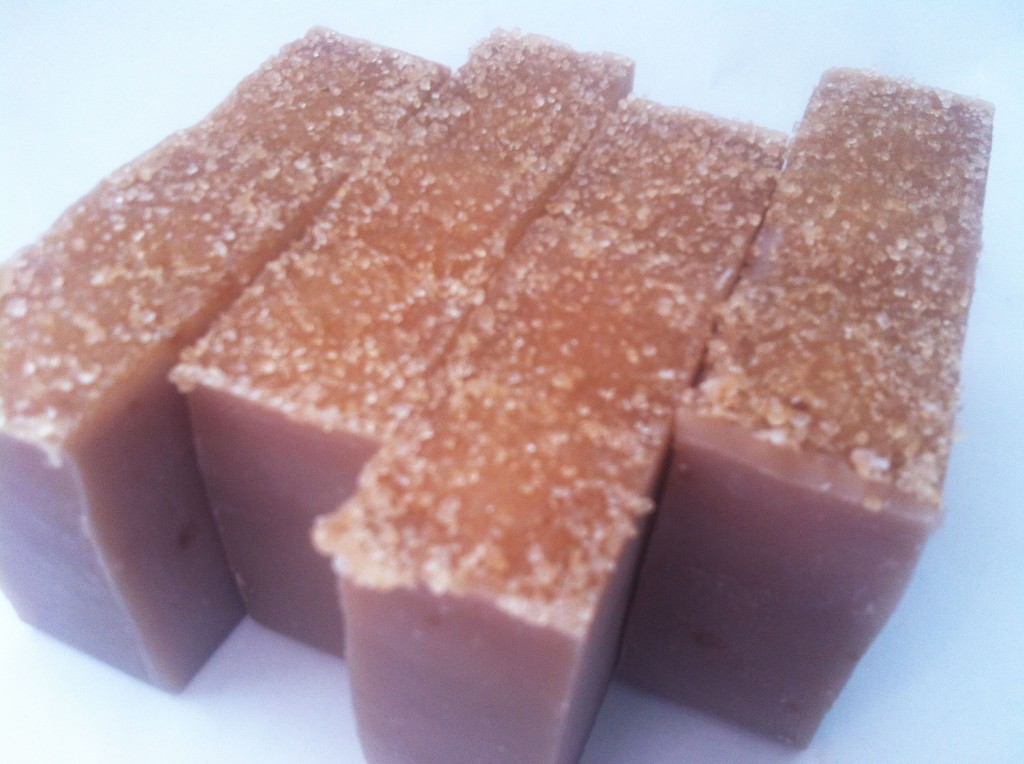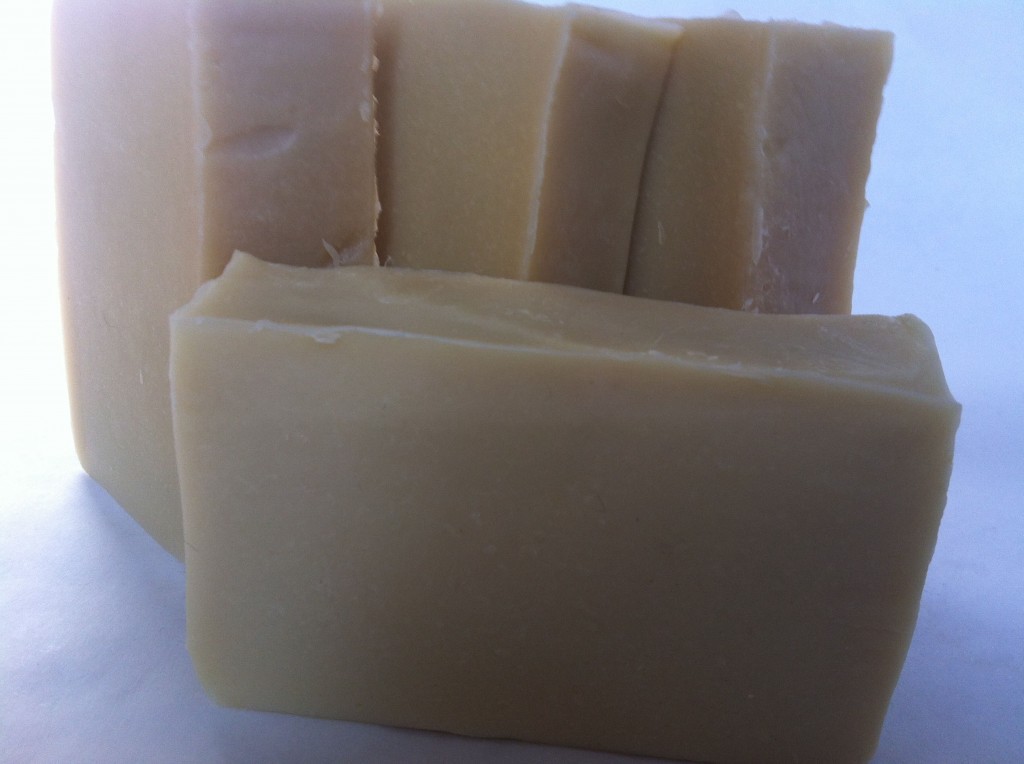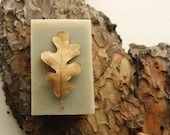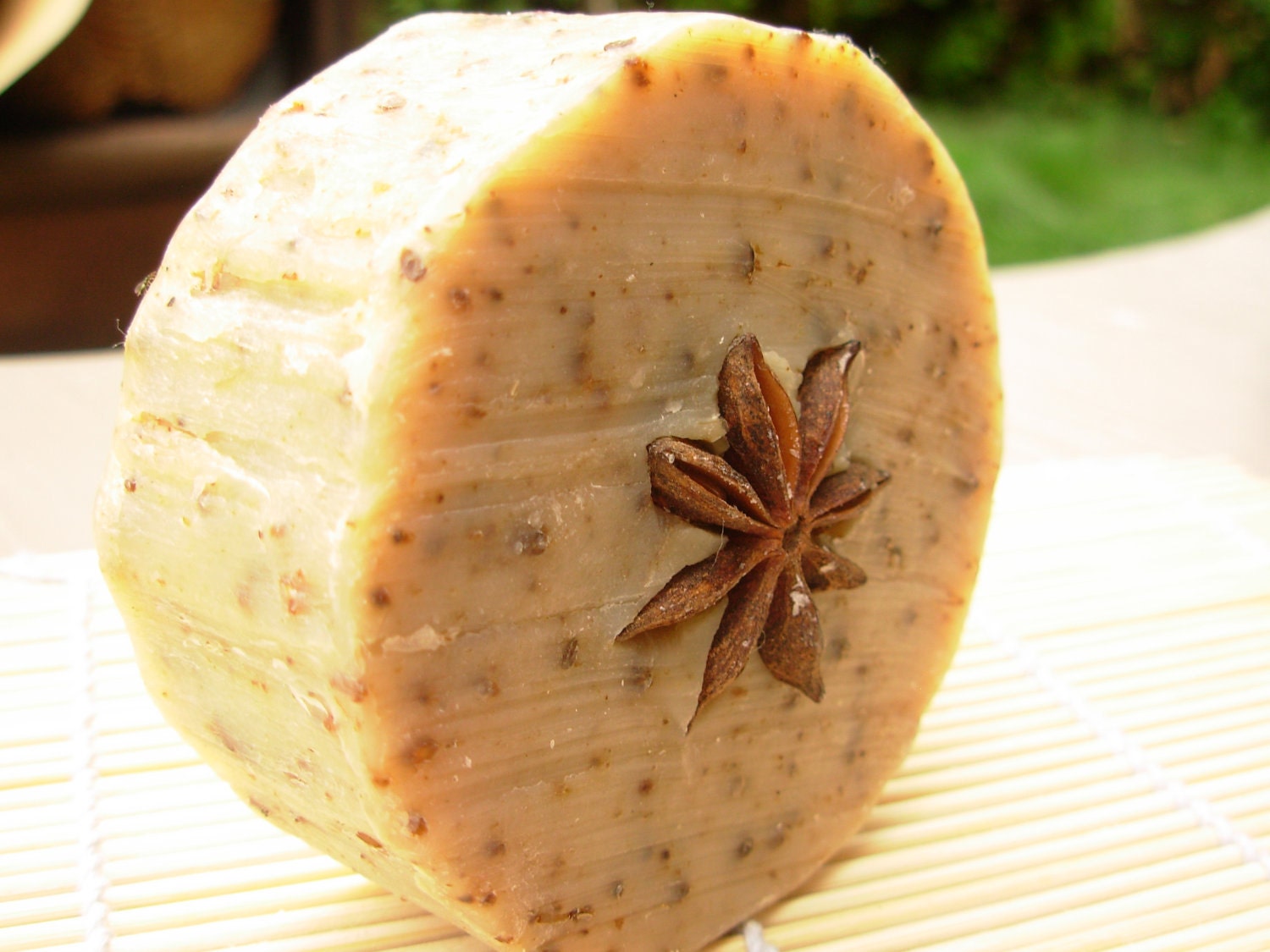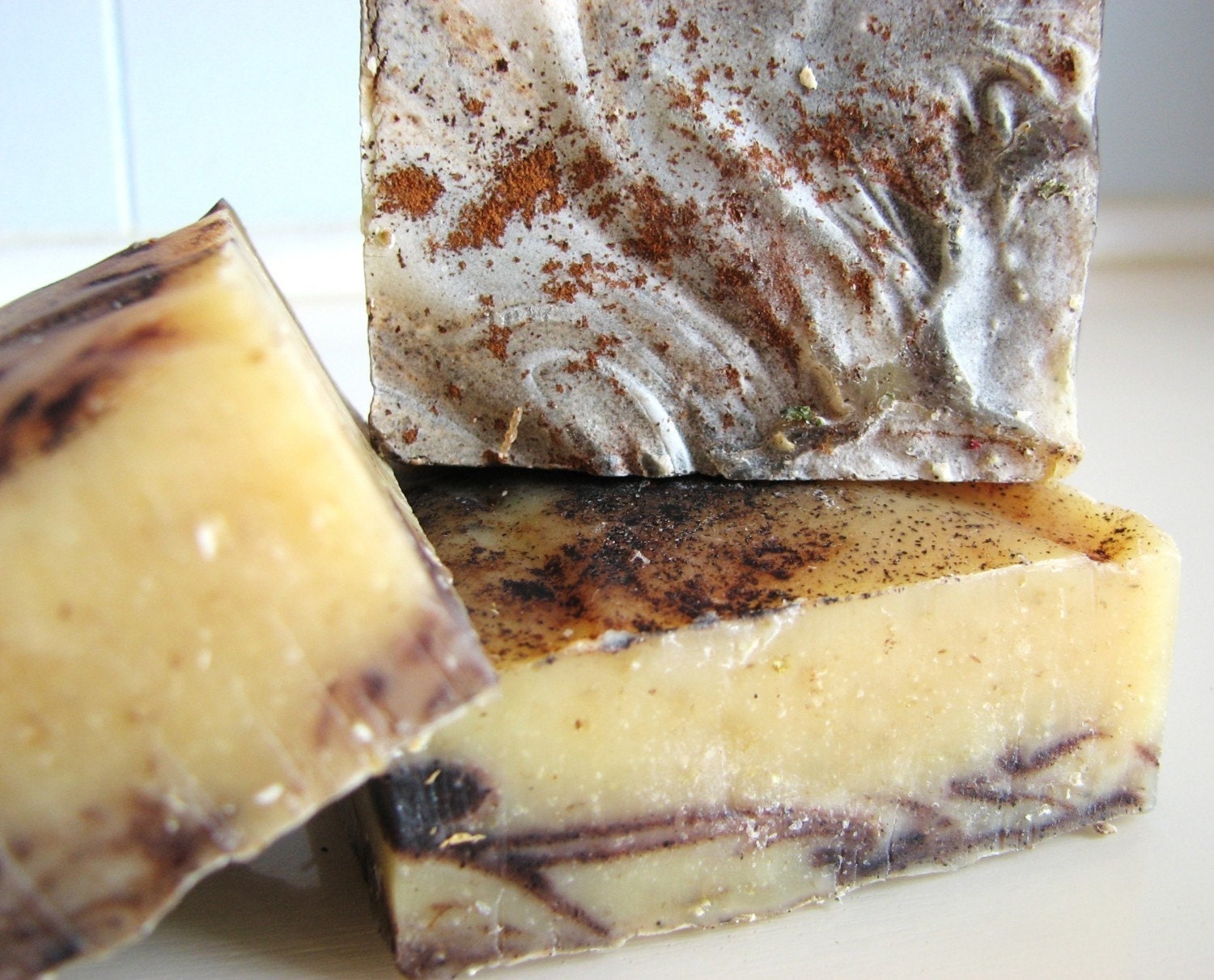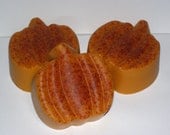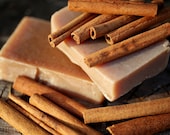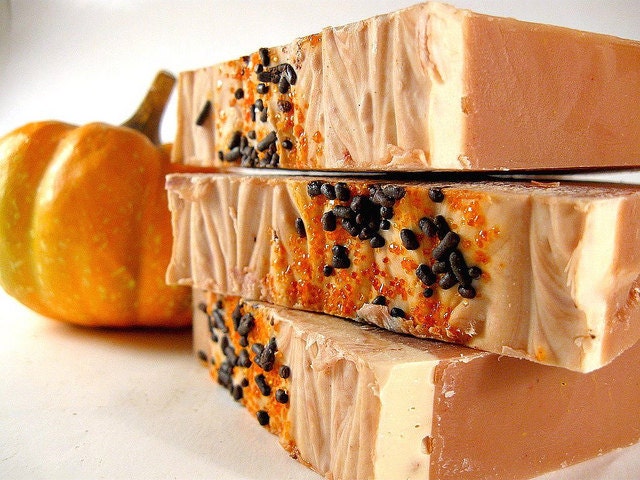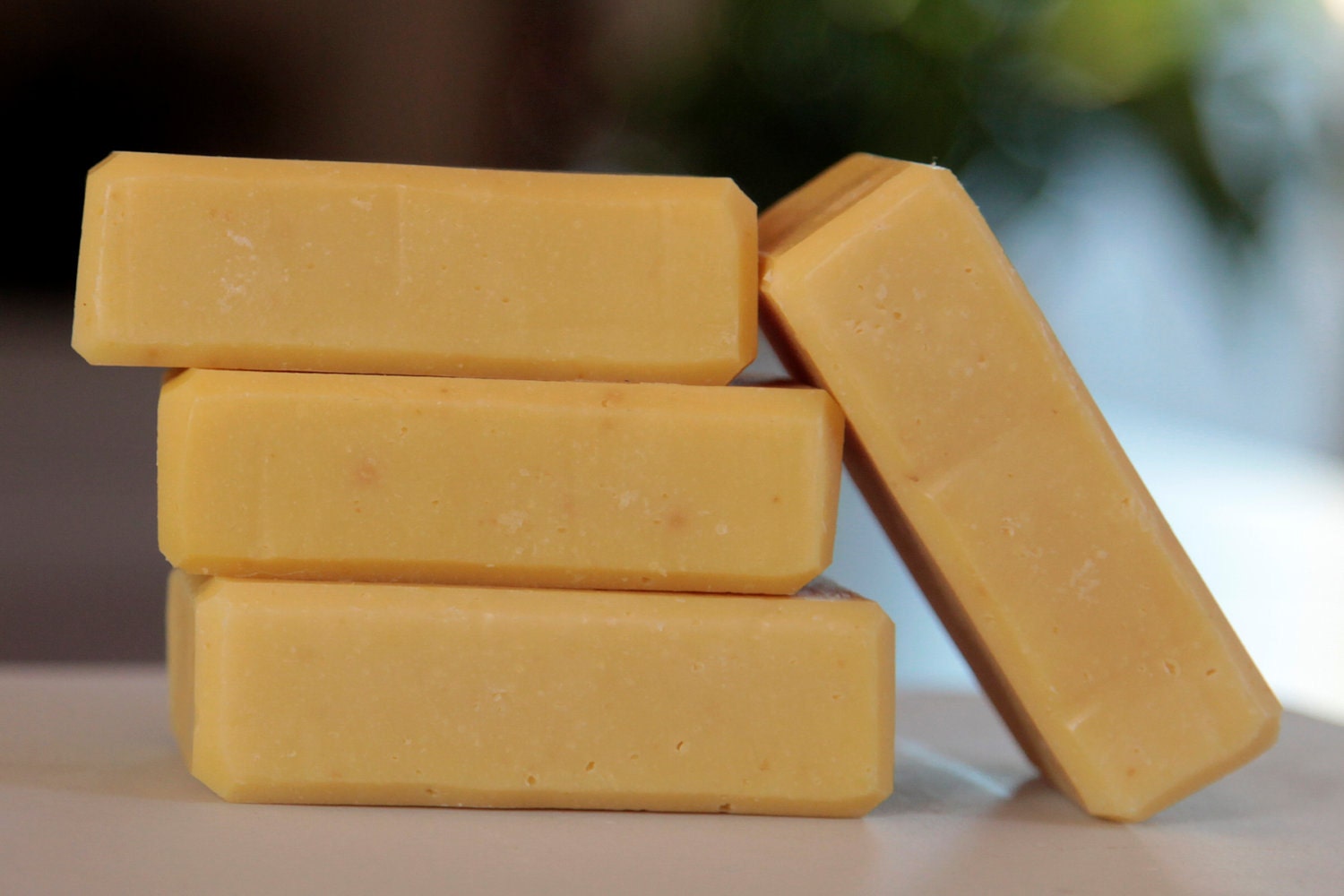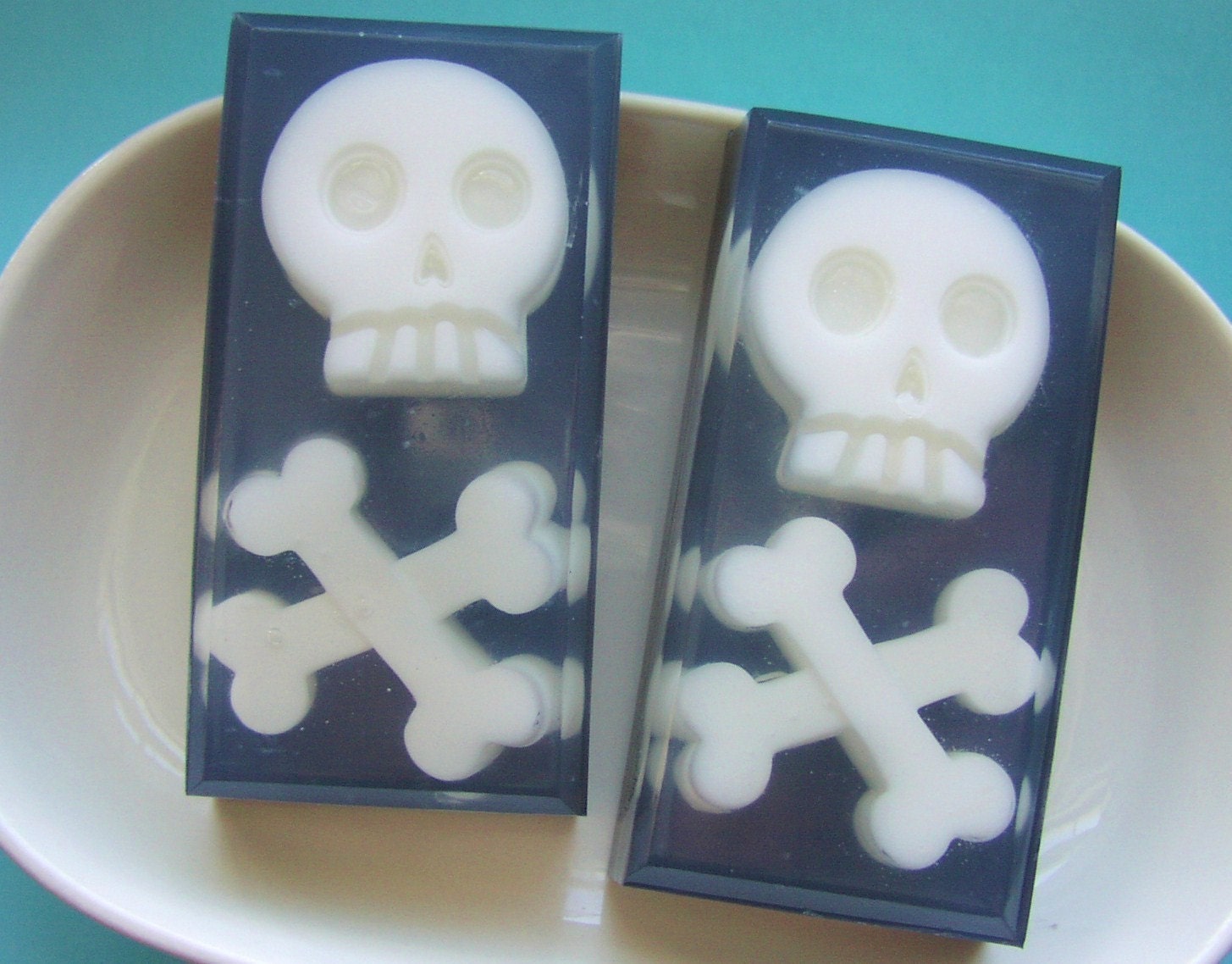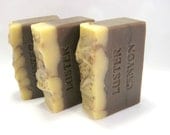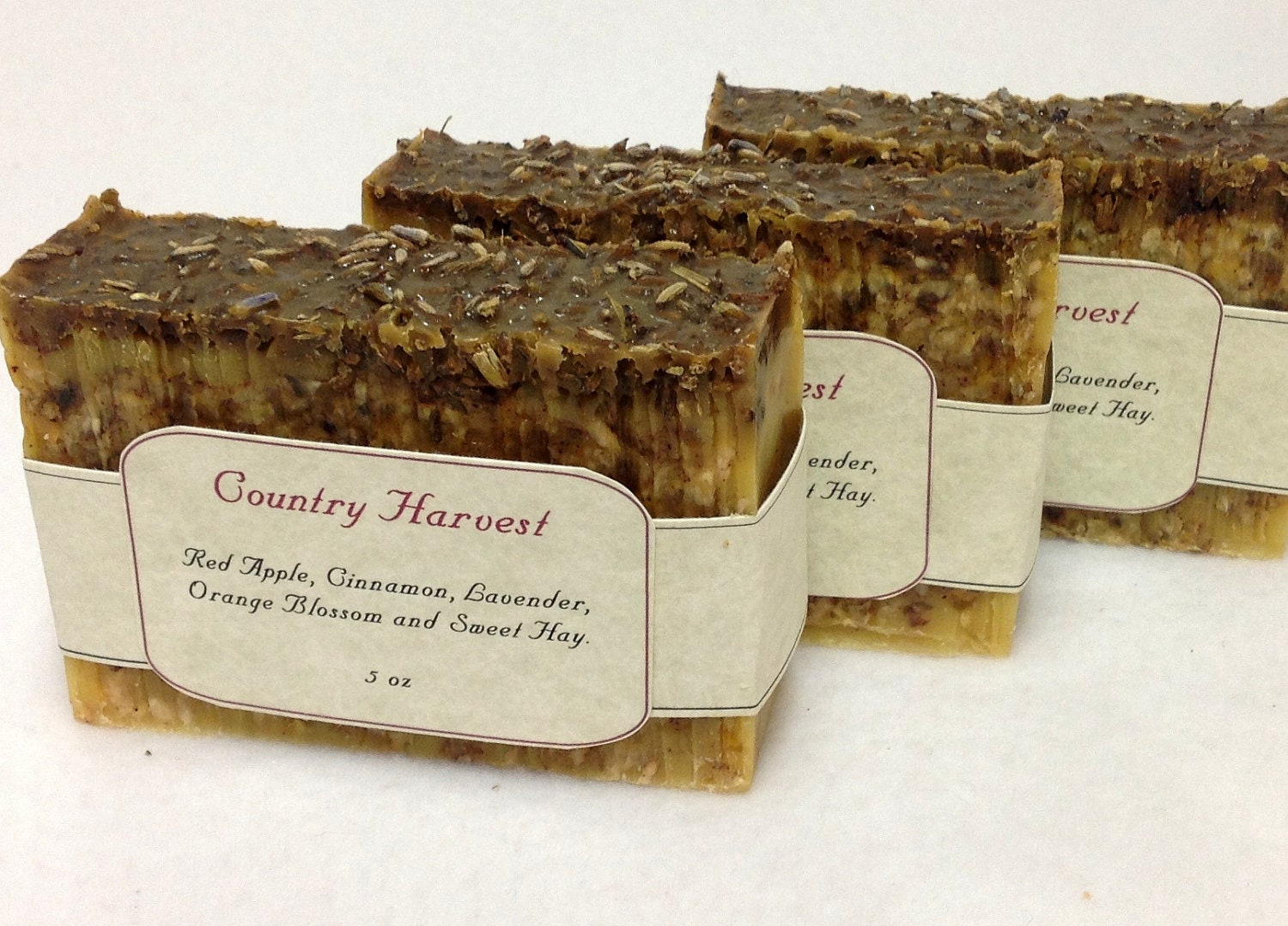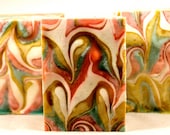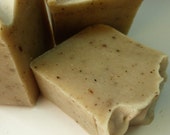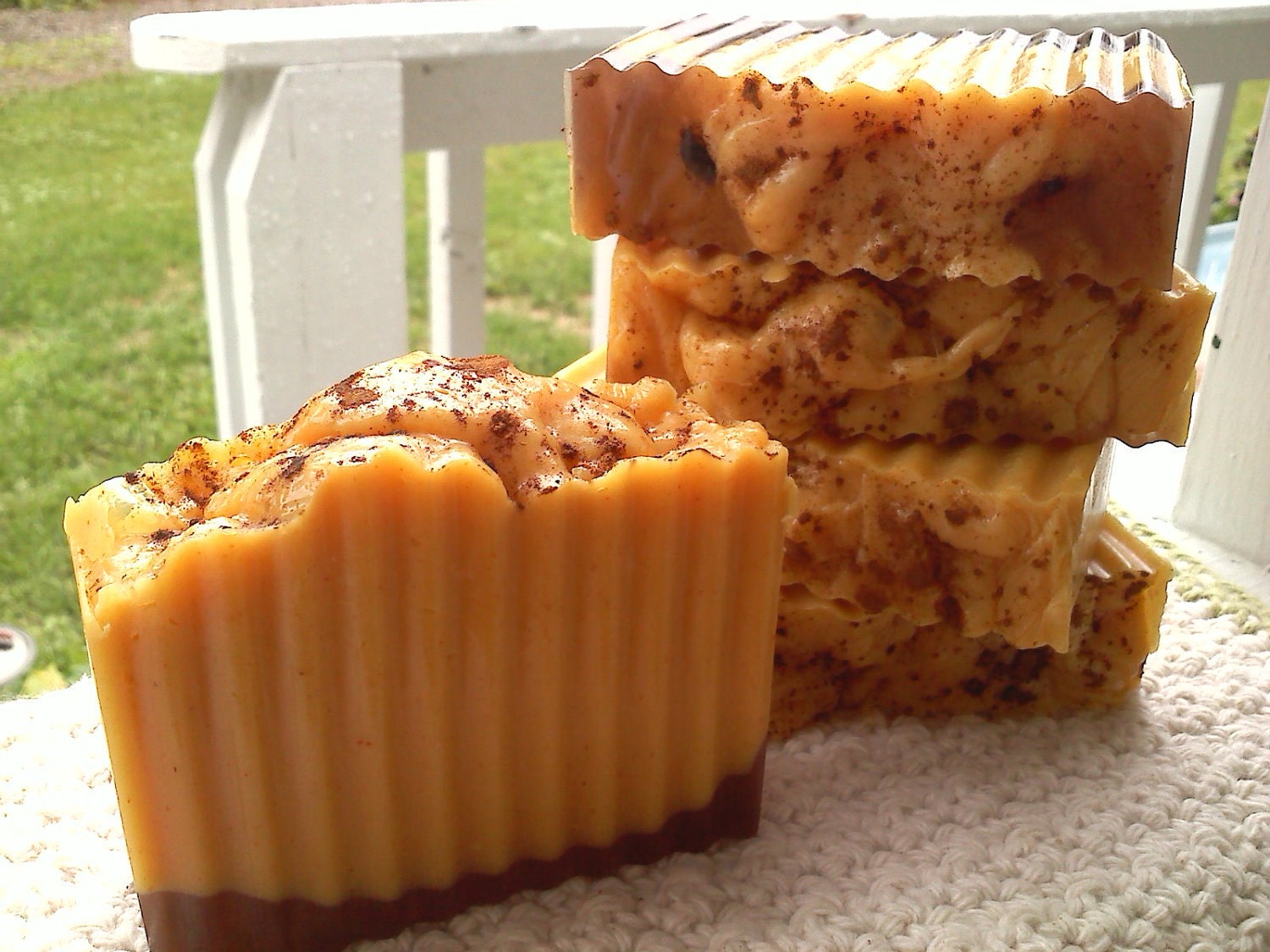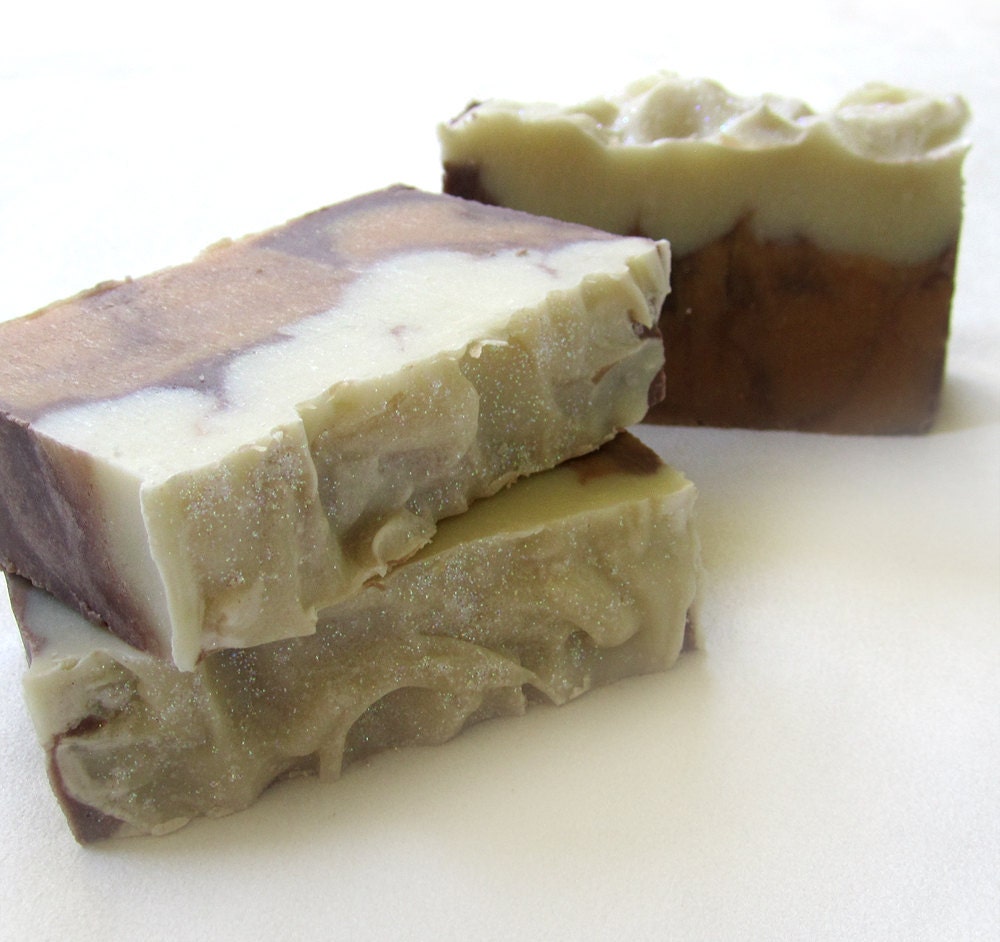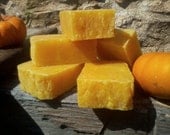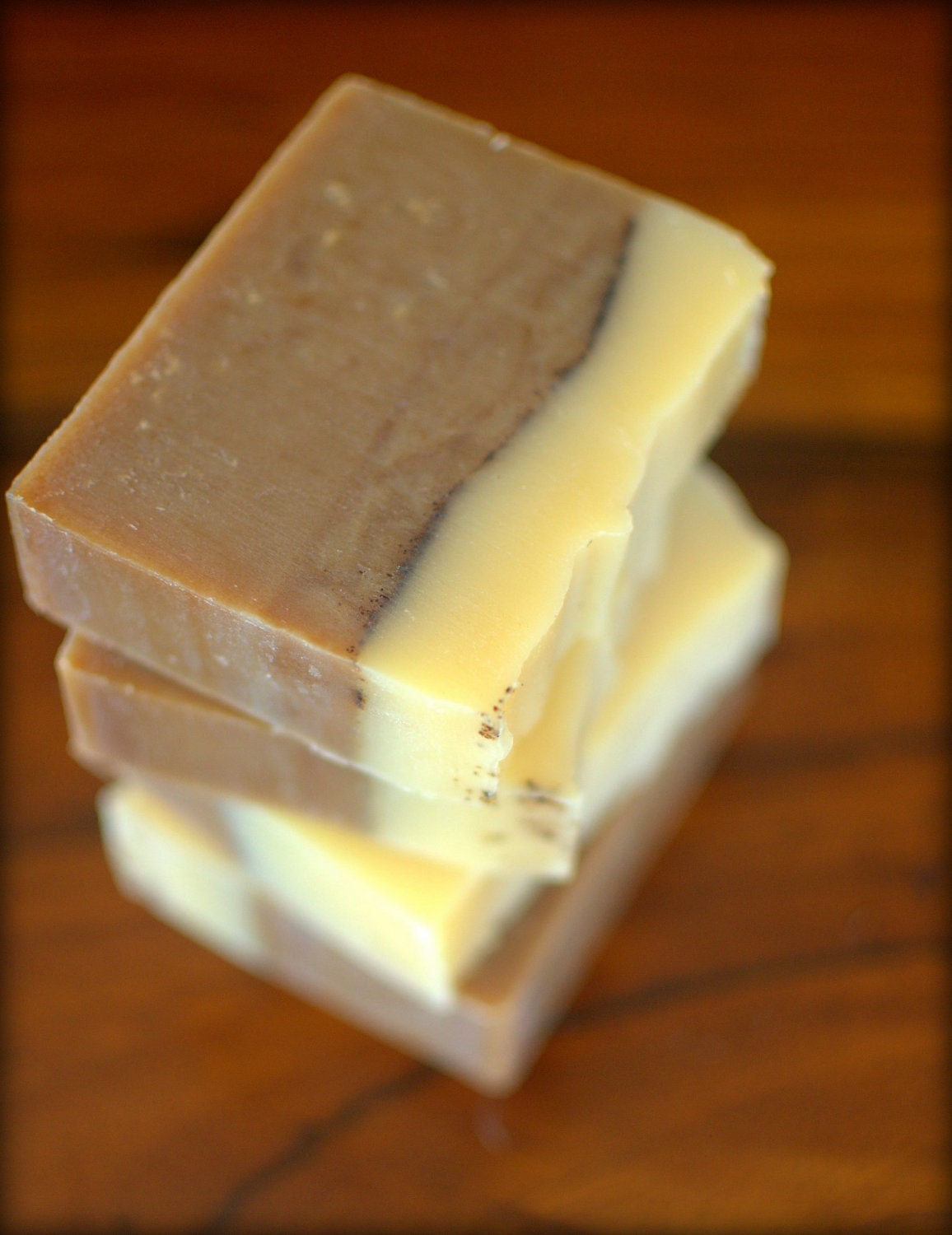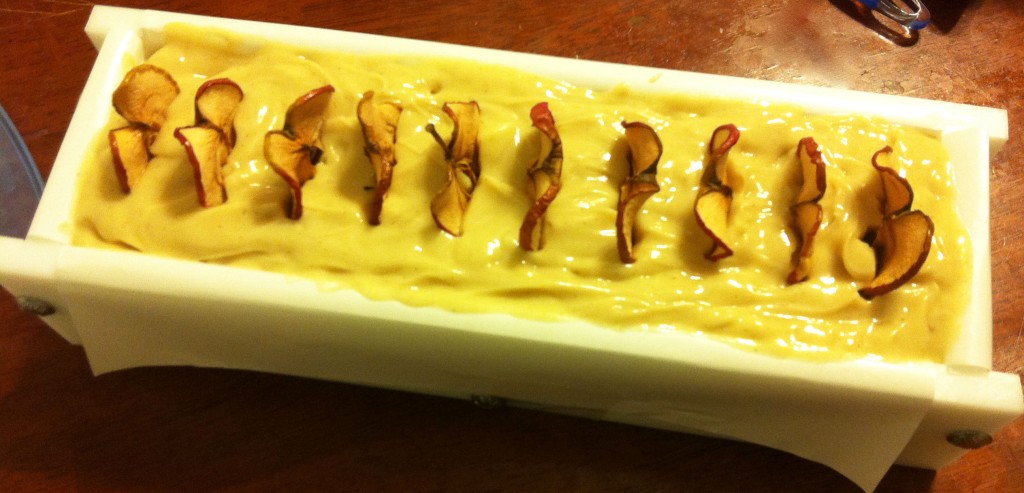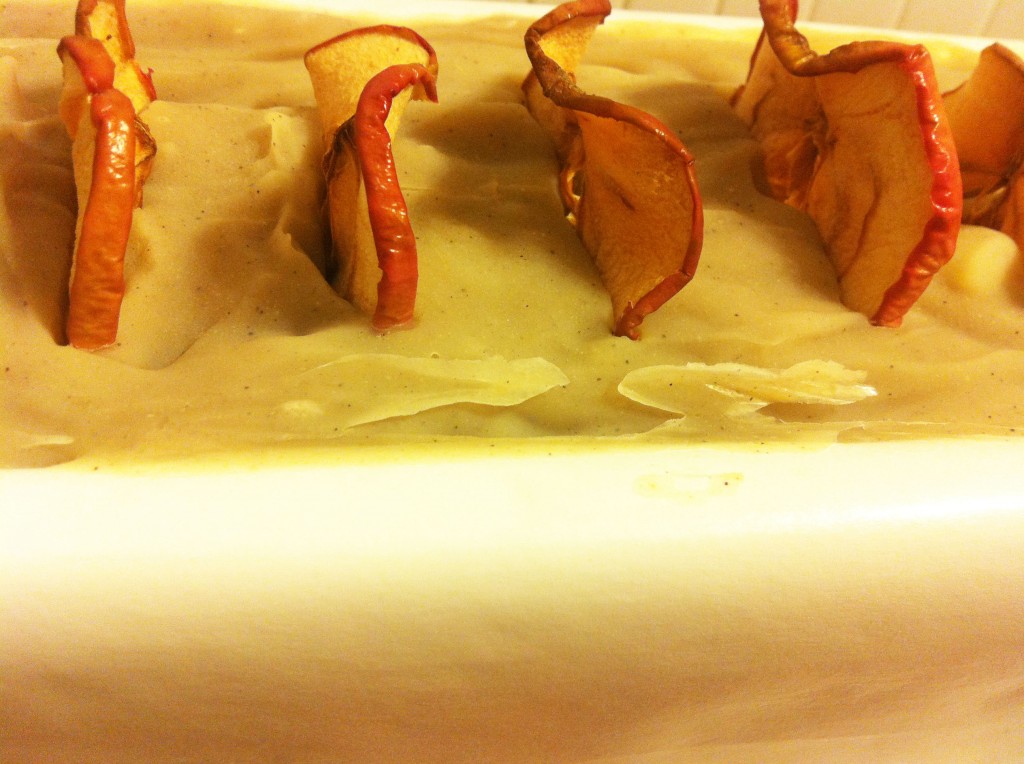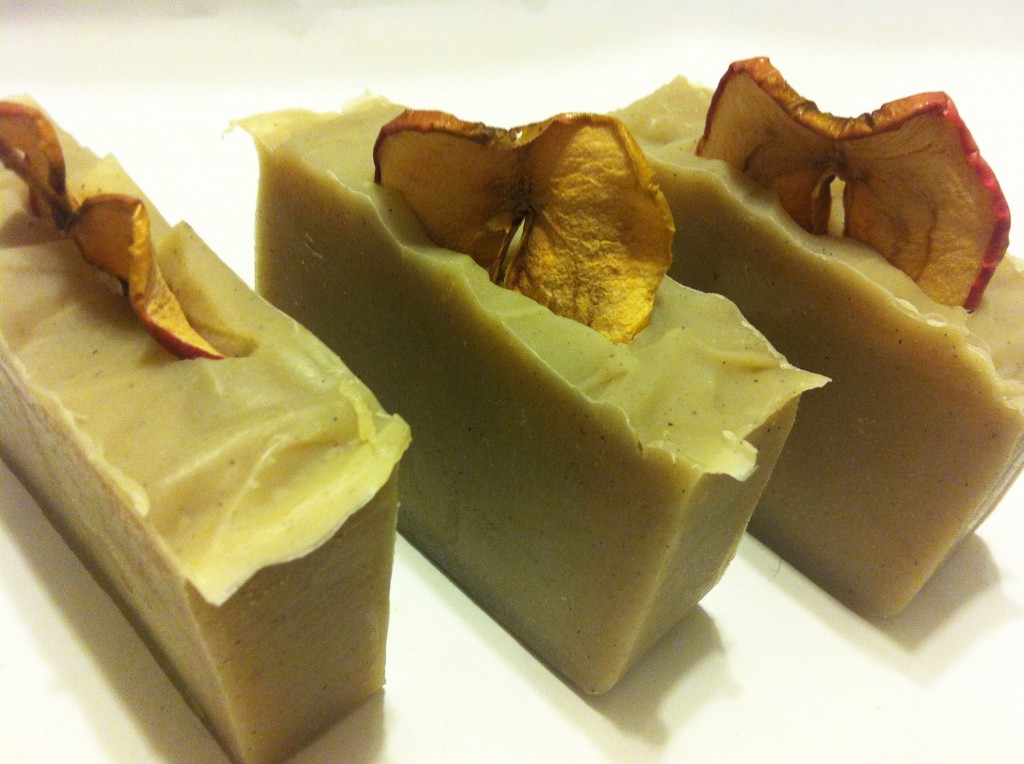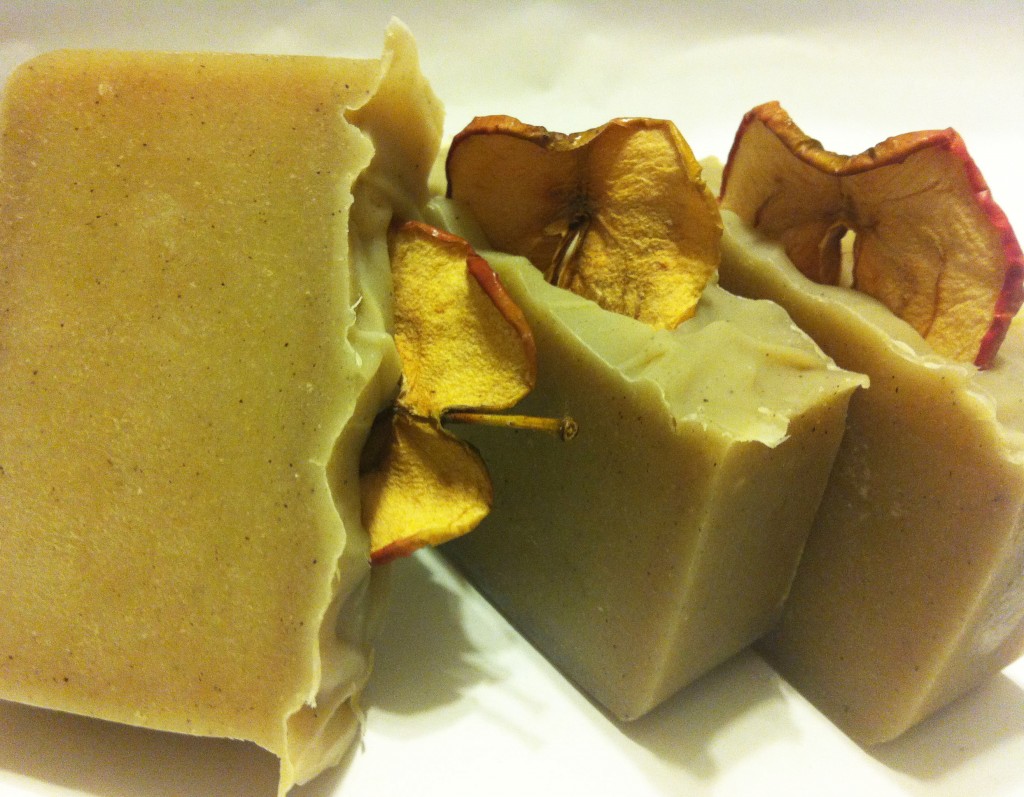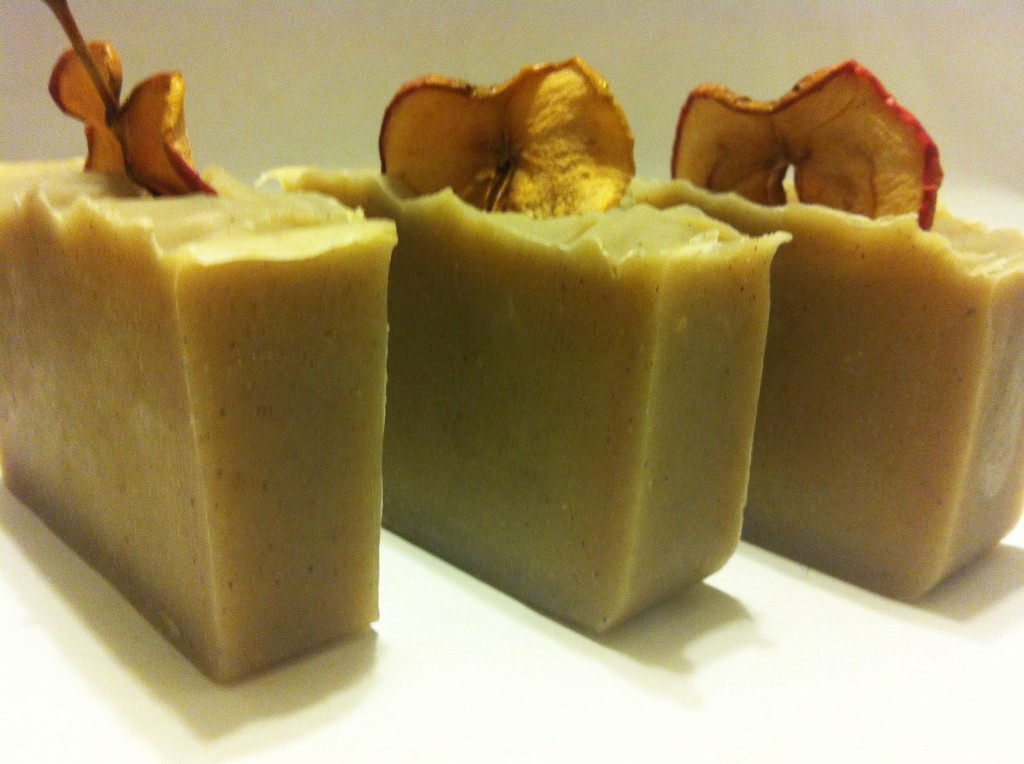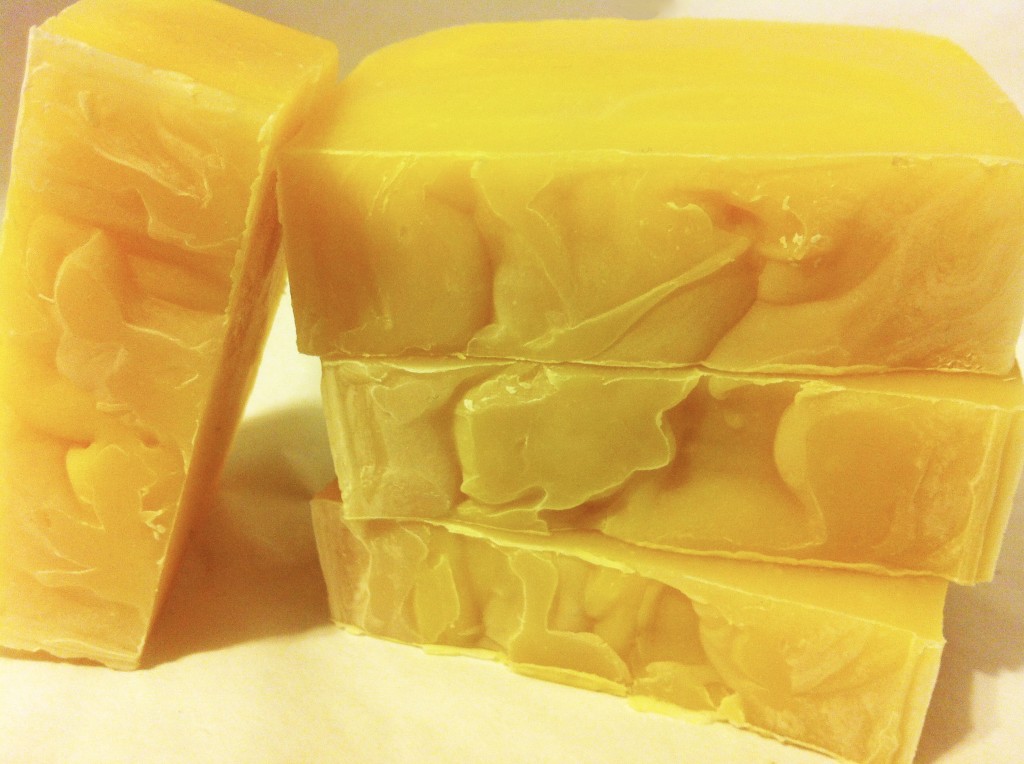 I cut the Sweet Jane soap this afternoon. The swirls are not terribly defined, which I expected. The yellow really pops after the soap has saponified. It’s lovely and smells great.
I cut the Sweet Jane soap this afternoon. The swirls are not terribly defined, which I expected. The yellow really pops after the soap has saponified. It’s lovely and smells great.
Author: Dana
Sweet Jane
I have been watching Celine Blacow’s instructional videos, and I can’t think of anyone else I’ve seen who is half as good at explaining how to swirl. She does many different swirling techniques, including the hanger swirl, which I’m dying to try—unfortunately, I don’t have any hangers. Well, that’s not true. I have a bunch of plastic ones I can’t bend. A co-worker said he’d donate a bunch to me. I’m looking forward to trying it out.
Here is Celine’s tutorial:
I ordered a few new colorants from Bramble Berry and did a successful in-the-pot swirl with three colors (Fizzy Lemonade, Ultramarine Violet Oxide, and Hydrated Chrome Green pigments) in a shampoo bar recipe with tea tree oil. Those bars are still very soft, but I’ll post a picture soon.
After trying it once, I decided to do another, but I wasn’t sure what I wanted to do. I realized I still had some Lemon Verbena fragrance oil from Bramble Berry, so I decided to do a coconut-milk based soap using the Fizzy Lemonade pigment and Lemon Verbena fragrance. I’m calling it Sweet Jane after Jane Bennet in Pride and Prejudice. Jane Austen’s classic novel celebrates its 200th anniversary on January 28, 2013! Anna Quindlen once describe Jane Bennet as “sugar to Elizabeth’s lemonade.” She always looks for the best in everyone. Here she is as portrayed by Rosamund Pike in the 2005 version of the film (she’s the blond).

Jane refrains from judgment. She’s quiet and serene. Lemon Verbena is a perfect complement to her sweetness of character. I imagine she smells exactly like Lemon Verbena. And the yellow not only complements the soap fragrance, but also alludes to Jane’s hair color, believed to be blonde. Jane wrote in a letter to her sister Cassandra:
Henry & I went to the Exhibition in Spring Gardens. It is not thought a good collection, but I was very well pleased—particularly (pray tell Fanny) with a small portrait of Mrs. Bingley, excessively like her. I went in hopes of seeing one of her Sister, but there was no Mrs. Darcy;—perhaps however, I may find her in the Great Exhibition which we shall go to, if we have time;—I have no chance of her in the collection of Sir Joshua Reynolds’s Paintings which is now shewing in Pall Mall, & which we are also to visit.—Mrs. Bingley’s is exactly herself, size, shaped face, features & sweetness; there never was a greater likeness. She is dressed in a white gown, with green ornaments, which convinces me of what I had always supposed, that green was a favourite colour with her. I dare say Mrs. D. will be in Yellow.
Martha Rainbolt argues in a 1988 English Language article entitled “The Likeness of Austen’s Jane Bennet: Huet-Villiers’ ‘Portrait of Mrs. Q” that this image may be the one Jane Austen saw:
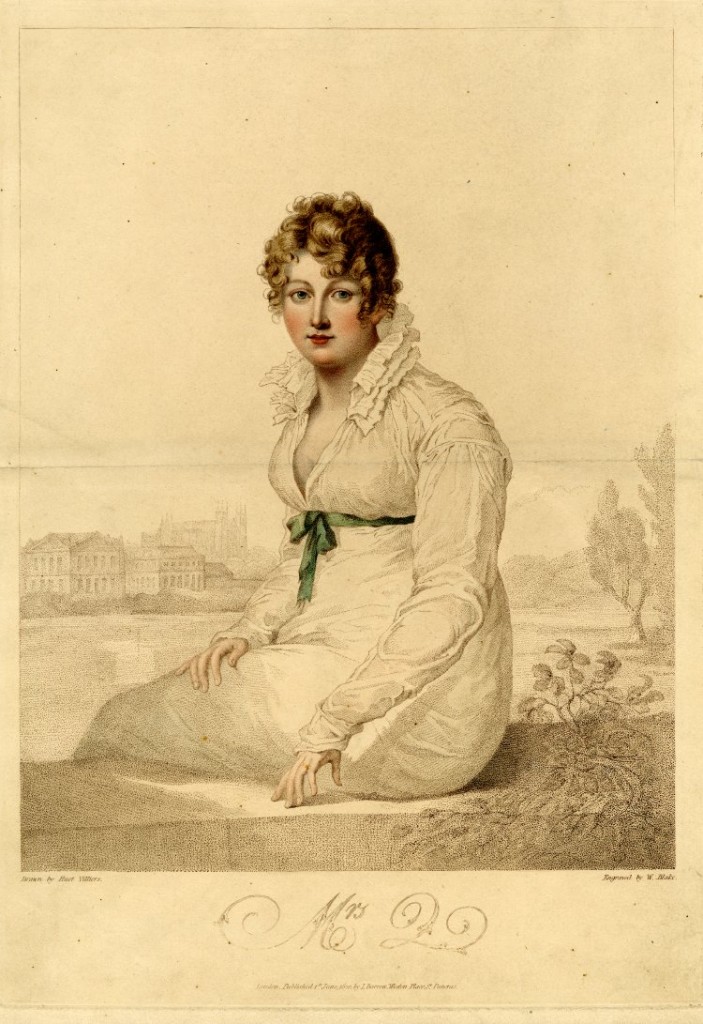 Seems logical to me based on the evidence I’ve seen. She’s a very sweet-faced lady.
Seems logical to me based on the evidence I’ve seen. She’s a very sweet-faced lady.
Doesn’t she look like she’d wear Lemon Verbena?
I’m not sure what I’m going to get with this soap. My experience with the Fizzy Lemonade colorant is that it doesn’t look like it has changed color at all when you add it to the soap batter, but after it has saponified, it is a very pretty yellow. Right now, it just looks yellow. Who knows what will happen when I cut it? I’ll post the cutting pictures tomorrow.
For the interested, here is the recipe:
- 30% olive oil
- 25% coconut oil
- 25% palm oil
- 10% sweet almond oil
- 5% cocoa butter
- 5% castor oil
By the way, in case you were wondering, yes, I will be making a soap for each of the major characters in Pride and Prejudice this year.
Related posts:
Savon de Marseille
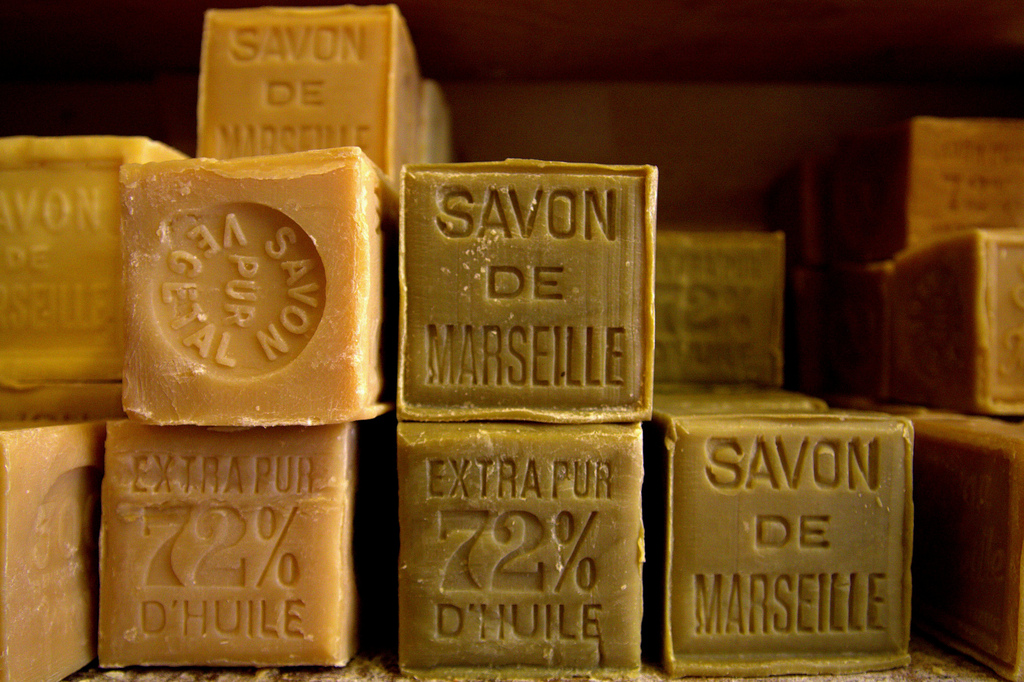 Have you ever heard of Savon de Marseille? Blocks of this special soap have been made in the South of France since 1370, when the first soapmaker is documented in Marseille. Louis XIV passed a law in 1688 stipulating that only soaps made in and around Marseille could use the name Savon de Marseille. One of the main qualifications of Savon de Marseilles is that it must be 72% olive oil. True Castile soaps are 100% olive oil (which is why it bothers me that Dr. Bonner’s bills itself as Castile when it’s not even mostly olive oil), but many soapmakers prefer to add additional oils, especially coconut oil, so that the soap will have a bubbly lather. The resulting soap is often called “Bastile.” Olive oil makes for small, flat bubbles, but adding a bit of coconut oil makes for a fairly nice soap.
Have you ever heard of Savon de Marseille? Blocks of this special soap have been made in the South of France since 1370, when the first soapmaker is documented in Marseille. Louis XIV passed a law in 1688 stipulating that only soaps made in and around Marseille could use the name Savon de Marseille. One of the main qualifications of Savon de Marseilles is that it must be 72% olive oil. True Castile soaps are 100% olive oil (which is why it bothers me that Dr. Bonner’s bills itself as Castile when it’s not even mostly olive oil), but many soapmakers prefer to add additional oils, especially coconut oil, so that the soap will have a bubbly lather. The resulting soap is often called “Bastile.” Olive oil makes for small, flat bubbles, but adding a bit of coconut oil makes for a fairly nice soap.
Savon de Marseille is made with water from the Mediterranean Sea, olive oil, and a mixture of other vegetable oils that varies according to the maker’s preferences. Most often, soapmakers use palm or a mixture of palm and coconut oils. It is traditionally unscented, but you may be able to find some scented versions. It is cut in blocks of about 300 grams and stamped as you see in the example above.
I was recently asked if I made any lavender soap. I haven’t yet. I did add some lavender essential oil to the first batch I made, but I was inexperienced at the time, and I didn’t realize I would have needed to have added quite a lot more lavender oil for the fragrance to survive the saponification process. I have decided to create a Marseille-style soap with French green clay and lavender oil. I won’t have the materials to make it until after the new year begins, most likely, but I’ll keep you posted about how it turns out.
If you are a soapmaker, are there any traditional types of soap you’re anxious to try (Castile, Aleppo, something similar)? If you are a fan of homemade soap, which traditional types of soap do you like best?
Swirling Success
I’ve been trying for some time to swirl two colors together with no success, but I finally did it!
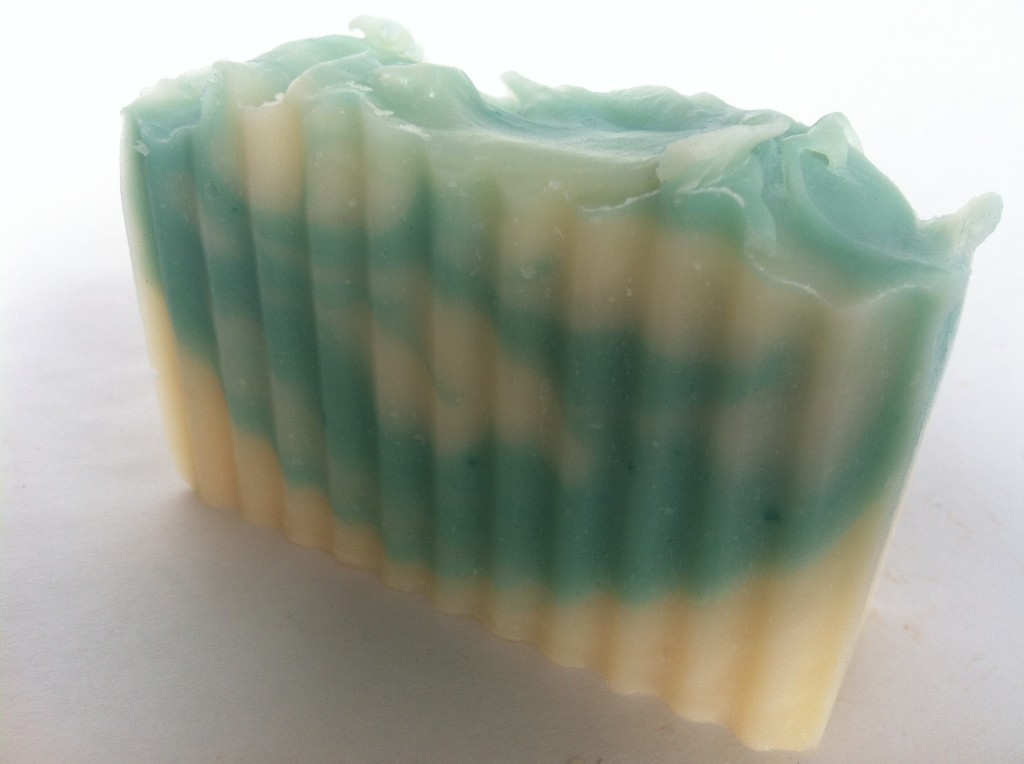 I created this soap because I didn’t have enough lemongrass essential oil to make a second batch of Lemongrass Sage today. Lemongrass Sage has turned out to be my most popular soap. I sold out of the supply I brought to a recent craft fair at my school, and I have sold several bars of it over this Thanksgiving weekend. I have to admit, it’s a great soap, and I use it myself on my face.
I created this soap because I didn’t have enough lemongrass essential oil to make a second batch of Lemongrass Sage today. Lemongrass Sage has turned out to be my most popular soap. I sold out of the supply I brought to a recent craft fair at my school, and I have sold several bars of it over this Thanksgiving weekend. I have to admit, it’s a great soap, and I use it myself on my face.
At a loss as to what type of soap to make, I decided to try something new. I had a coconut lime verbena scent I had been meaning to try, and I had some green colorant left over from making the Cucumber Yogurt batch (as it turns out, I needed to use a lot more colorant to make the soap look greenish), so I decided to try swirling again.
Ingredients:
- 30% olive oil
- 25% coconut oil
- 25% palm oil
- 10% avocado oil
- 5% cocoa butter
- 5% castor oil
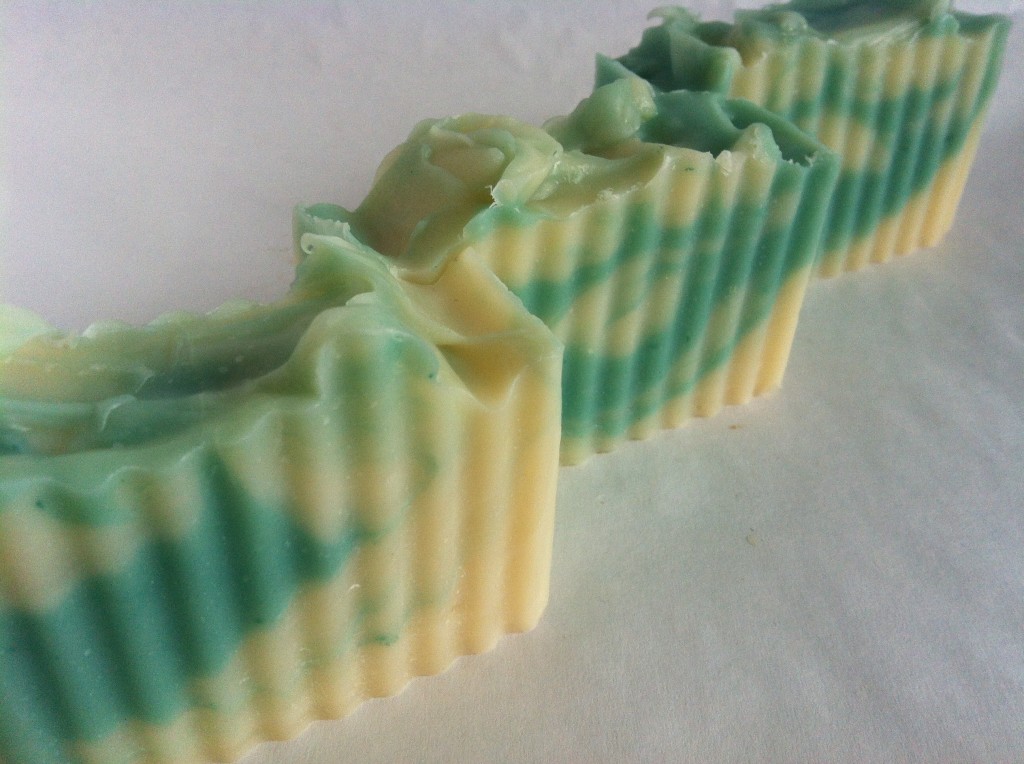 I started to use yogurt as a base when it occurred to me I should try coconut milk instead because of the coconut lime verbena scent. I knew I wanted the white part of the soap to be as white as possible without using titanium dioxide (I don’t have any). My shea butter is raw, unrefined shea butter, and it has a yellow cast that makes my white soaps a more yellow shade of cream. The cocoa butter I have is white, and I noticed when I used it to make the Vanilla Sugar Cane soap that the soap batter was much whiter than normal, though because of the vanillin in the fragrance I used, the soap later turned a browner color. So, I decided to use cocoa butter in this recipe when I usually use shea. On a whim, I also decided on avocado oil instead of sweet almond or a full 40% olive oil. No particular reason aside from wanting to experiment. Avocado oil is good for people with sensitive skin, and it has vitamins A, D, and E.
I started to use yogurt as a base when it occurred to me I should try coconut milk instead because of the coconut lime verbena scent. I knew I wanted the white part of the soap to be as white as possible without using titanium dioxide (I don’t have any). My shea butter is raw, unrefined shea butter, and it has a yellow cast that makes my white soaps a more yellow shade of cream. The cocoa butter I have is white, and I noticed when I used it to make the Vanilla Sugar Cane soap that the soap batter was much whiter than normal, though because of the vanillin in the fragrance I used, the soap later turned a browner color. So, I decided to use cocoa butter in this recipe when I usually use shea. On a whim, I also decided on avocado oil instead of sweet almond or a full 40% olive oil. No particular reason aside from wanting to experiment. Avocado oil is good for people with sensitive skin, and it has vitamins A, D, and E.
I mixed the oils with the coconut milk and lye, added the fragrance, and divided the batch in half. I colored one half. By the time I had the colored portion ready, the white portion had already reached the consistency of very thick pudding, or perhaps mashed potatoes like I make them (whipped potatoes, really). I started to lament a little bit, thinking of my Amy Lowell Lilac Soap, when I remembered a swirling technique I learned on YouTube:
The swirling technique Celine described saved my soap! I think it turned out gorgeous. It smells heavenly. I can’t wait to try it with another kind of soap. One of the interesting things about swirling is that each time the soap is different. Each individual bar is different. You just don’t know what you will get. I’m very pleased with how the soap turned out.
 The soap is beautiful, and I love the coconut lime scent. I’m also proud of the way the soap itself turned out with the coconut milk base. I admit I was excited about the idea when I remembered I had some frozen coconut milk I could use.
The soap is beautiful, and I love the coconut lime scent. I’m also proud of the way the soap itself turned out with the coconut milk base. I admit I was excited about the idea when I remembered I had some frozen coconut milk I could use.
Coconut Lime Verbena by Dana Huff is licensed under a Creative Commons Attribution-NonCommercial 3.0 Unported License.
Permissions beyond the scope of this license may be available at Suds Life: About.
Vanilla Sugar Cane Soap
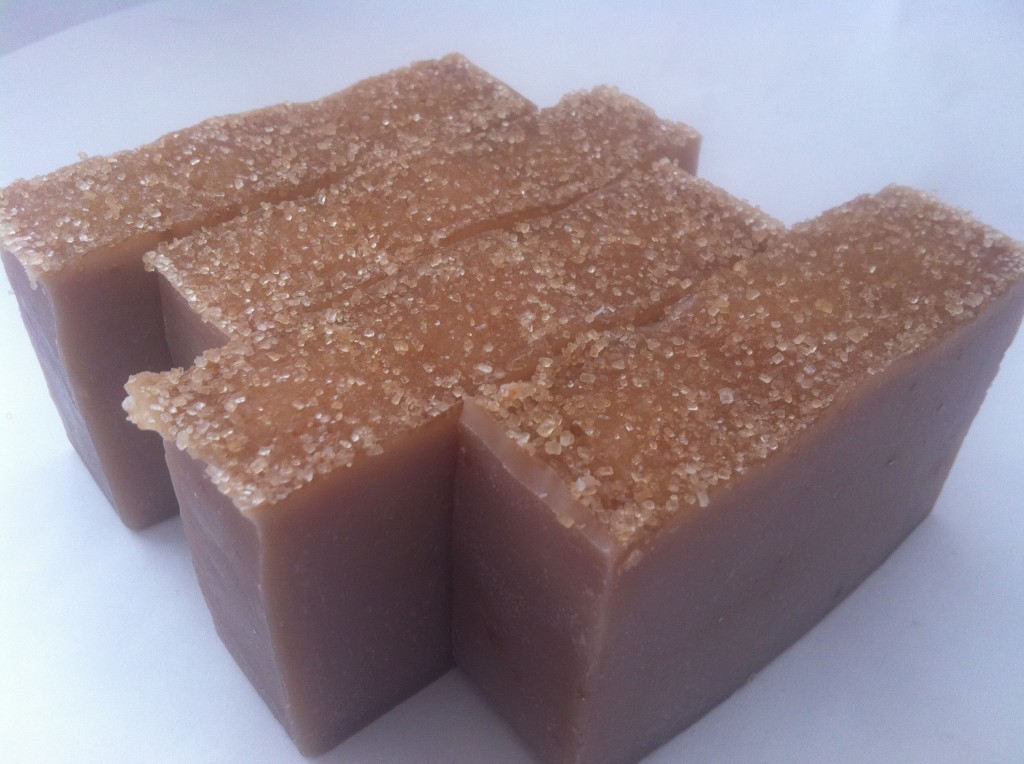 Inspired by Attica Locke’s new novel The Cutting Season, I created a new soap using some ingredients I had been wanting to try for some time.
Inspired by Attica Locke’s new novel The Cutting Season, I created a new soap using some ingredients I had been wanting to try for some time.
Ingredients
- 30% olive oil
- 25% coconut oil
- 25% palm oil
- 10% sweet almond oil
- 5% cocoa butter
- 5% castor oil
I had never soaped with sweet almond oil and castor oil, and I was really pleased with the consistency of the soap. I used Nature’s Garden’s Warm Vanilla & Sugar fragrance oil. It smells exactly like Bath & Body Works’s Warm Vanilla Sugar fragrance, which happens to be one of my favorites. I layered the top of the soap with raw sugar.
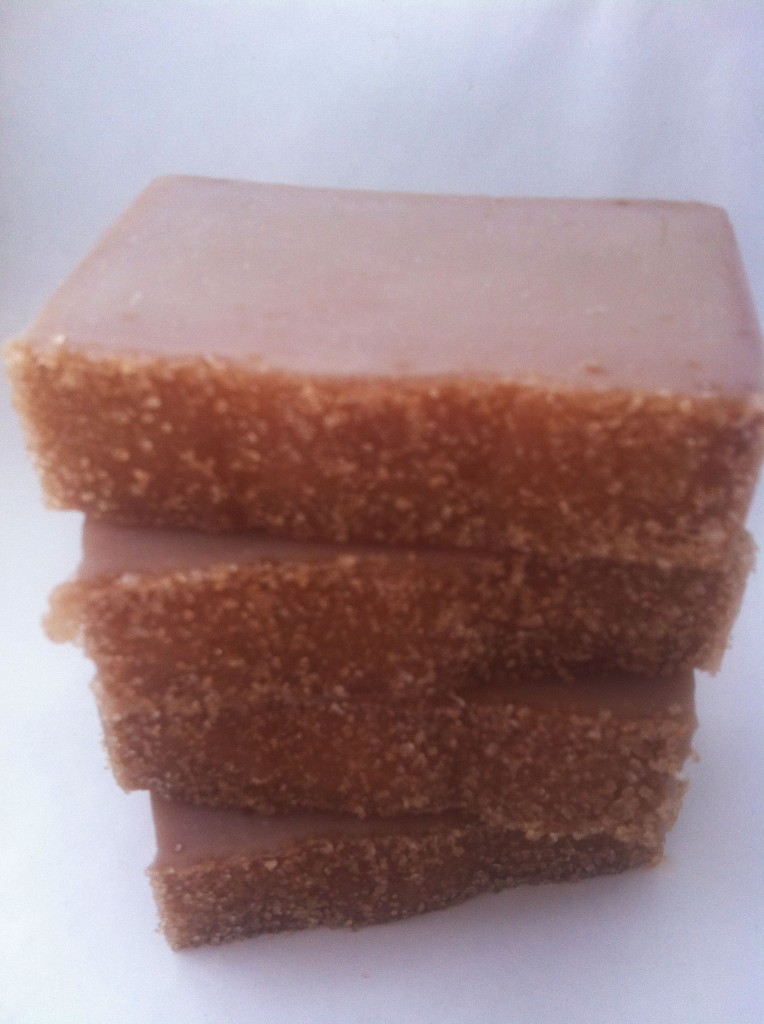 Because the fragrance oil has vanilla in it, it has discolored the soap, which I expected and did not mind. I am not sure if it will continue to darken as it cures, but I’m not worried. Even if it darkens more, I think it will still be a beautiful soap.
Because the fragrance oil has vanilla in it, it has discolored the soap, which I expected and did not mind. I am not sure if it will continue to darken as it cures, but I’m not worried. Even if it darkens more, I think it will still be a beautiful soap.
It should be ready to sell in the Etsy store by the last week of November. It smells great. I cannot wait until it’s ready to use.
Cucumber Yogurt Soap
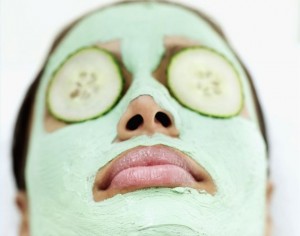 I’ve been wanting to make a cucumber yogurt bar for a long time. Heidi Corley Barto has a recipe for a soap using a cucumber purée in her book The Natural Soap Chef, and after reading about the testers’ reaction to Anne L. Watson’s Yogurt Parfait soap in Milk Soapmaking, I decided I should try to combine the two. A quick Google search told me I was not the first person to have this idea. After all, it makes sense. Don’t spas give cucumber/yogurt facials, after all? If those two ingredients weren’t wonderful for your face, then the spas wouldn’t be charging the big bucks for facial treatments.
I’ve been wanting to make a cucumber yogurt bar for a long time. Heidi Corley Barto has a recipe for a soap using a cucumber purée in her book The Natural Soap Chef, and after reading about the testers’ reaction to Anne L. Watson’s Yogurt Parfait soap in Milk Soapmaking, I decided I should try to combine the two. A quick Google search told me I was not the first person to have this idea. After all, it makes sense. Don’t spas give cucumber/yogurt facials, after all? If those two ingredients weren’t wonderful for your face, then the spas wouldn’t be charging the big bucks for facial treatments.
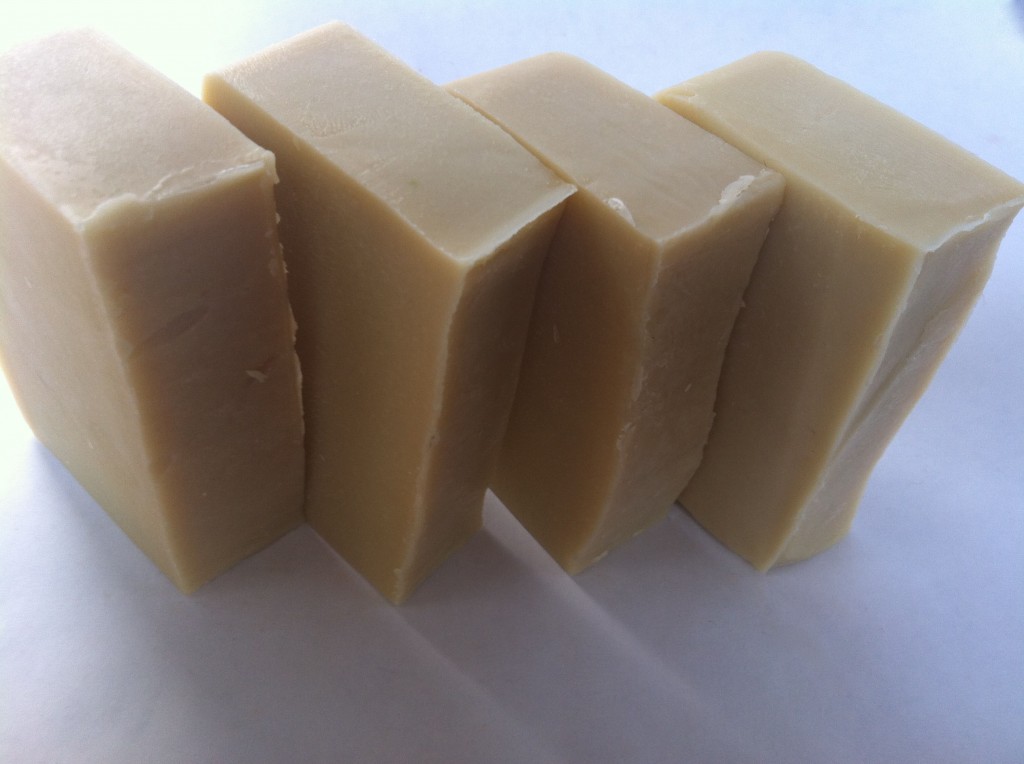 Recipe
Recipe
- 250 g coconut oil
- 225 g palm oil
- 120 g shea butter
- 275 g olive oil
- 200 g avocado oil
- 55 g castor oil
155 g lye
186 g cucumber-water purée
187 g plain whole milk yogurt
The Process
First I peeled two small cucumbers and shaved off the seeds with my peeler as well. Barto suggested using English cucumbers because they have fewer seeds, but I either couldn’t find them, or my store didn’t have them, so I just opted for some small pickling cucumbers. I imagine you could just use one big cucumber, but since it was the first time I made this soap, I wanted to go with smaller cucumbers in case one was enough. After I peeled and deseeded the cucumbers, however, I decided two was probably more like it. I added distilled water to the cucumbers and puréed them in my blender. Barto also suggested not peeling the cucumbers so that the peel added pigment, but I wasn’t too sure about that, so I peeled them.
I mixed half cucumber-water purée with half yogurt and froze the mixture in an ice cube tray. When I was ready to make the soap, I mixed the lye with the frozen cucumber-yogurt cubes and melted my shea butter, coconut oil, and palm oil in a large bowl. Then I added olive oil, avocado oil, and castor oil to the melted hard oils. Once the cucumber-yogurt and lye mixture was 90°, I added it to the oils and stick blended it to a light trace. Then I added a tiny bit of green pigment that didn’t really wind up coming through in the soap, and a very nice cucumber melon fragrance oil from Nature’s Garden, a new favorite vendor that has reasonable prices and a wide variety of products.
Cucumber Yogurt Soap by Dana Huff is licensed under a Creative Commons Attribution-NonCommercial 3.0 Unported License.
Permissions beyond the scope of this license may be available at Suds Life: About.
Facial Mask Image via eHow
Fall Soaps on Etsy
I love to support my fellow handmade soapers. Check out some of the wonderful fall soaps I found.
'Fall Soaps' by danahuff
It's October! The leaves are changing, the air is crisper, and that means fall-inspired soaps are starting to show up in Etsy stores.
Related posts:
Bookish Goodness
I’m a huge reader, and my new favorite books to read are soap making books (naturally!).
My sister just sent me a package with all these amazing books inside:
How exciting is that? All kinds of soapy goodness to read.
Plus, I made my first batch of soap inspired by my fall reads today. I’m not quite done with Ray Bradbury’s novel Something Wicked This Way Comes yet, but I can’t imagine I’ll read about a more indelible sensory image (at least, not one than can be made into soap) than Mr. Crosetti’s cotton candy. The book explores the theme of recaptured or lost youth and regret. I loved the idea of adding moisturizing yogurt as a lye base. The soap is in the mold now. Look how pretty it is!
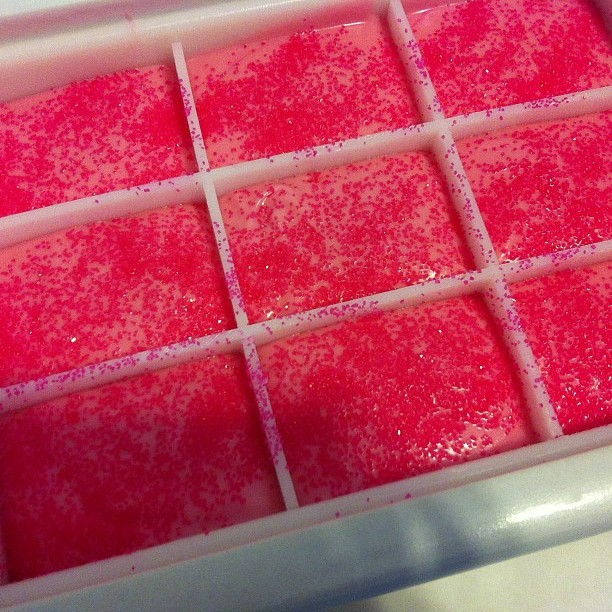 The pink sugar reminds me of how pink cotton candy looks when you’ve licked it. Smells great! I used Bramble Berry’s Electric Bubble Gum pigment and Nature’s Garden’s Cotton Candy Fragrance Oil. Yum!
The pink sugar reminds me of how pink cotton candy looks when you’ve licked it. Smells great! I used Bramble Berry’s Electric Bubble Gum pigment and Nature’s Garden’s Cotton Candy Fragrance Oil. Yum!
More pictures when I unmold it.
Making Milk Soaps
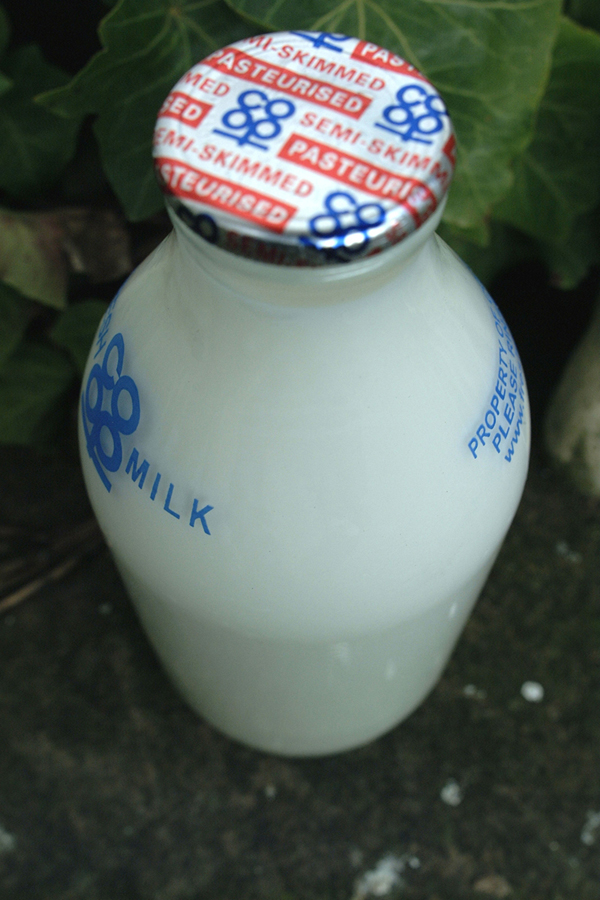 After making a few milk-based soaps, even considering some spectacular failures and the extra work involved, I have come to the conclusion that I really enjoy making milk soap.
After making a few milk-based soaps, even considering some spectacular failures and the extra work involved, I have come to the conclusion that I really enjoy making milk soap.
Earlier this week, I made a yogurt-based soap using a recipe in Anne L. Watson’s Milk Soapmaking. The yogurt feels great, but I tried to control the heat (possibly unnecessarily) by putting it in the freezer, and it partially gelled, leaving an oval ring in the middle of each bar. I am not sure what to do with it now. I might cut it up and incorporate it other soaps. It did turn out a pretty yellow color naturally just because I added some lemon zest. It might be nice as a confetti in another soap. My point (and I do have one) is that I really enjoyed making the soap. Today I made another batch of my chocolate milk soap, and I enjoyed making that, too.
I think one of the reasons I enjoy making milk-based soap is that it’s just a bit more challenging. The milk really seems to behave better with the lye if it’s frozen first. Adding the lye slowly also helps. I usually add a bit of lye, stir it completely, and then add a bit more, repeating these steps until all the lye is dissolved. It can take 15 minutes or more, but while I’m doing it, I feel so relaxed and peaceful, but also focused. I find this extra step in making soap enjoyable, particularly when the results are good. I’m looking forward to trying new milk-based soaps and refining the technique of making milk soaps.
Cinnamon Apple Cider Soap
The weekend before last, Steve and I took the kids to Tougas Family Farm to pick apples. I decided to try to use some of the apples in a soap, especially because I had ordered an apple cider fragrance oil from Bramble Berry. I added a tiny bit of cinnamon bark essential oil and cinnamon to the recipe, and the soap came out beautifully.
Here is the soap right after I poured it into the mold and stuck the apple slices in. It soaped up really well.
I wasn’t sure what color the soap would turn. Fragrance oils, fats, and oils used in soap all contribute different properties to the color, and when you don’t use a colorant, sometimes the results are interesting. They are usually some natural shade from beige to brown, but you don’t often know precisely what you’re going to get.
Here is the soap after 24 hours of saponification.
I couldn’t believe how close the color was to the true color of applesauce. The soap looks and smells exactly like applesauce to me. It came out wonderful. I was really pleased.
I decided not to trim the bar at all. I like how it the soap looks just as it was cut.
I love the one bar with the stem.
It will cure for four weeks, and then I will sell it in very limited quantities in my Etsy store.
The recipe:
- 35% olive oil
- 25% coconut oil
- 25% palm oil
- 10% shea butter
- 5% castor oil
I also added four tablespoons of Bramble Berry’s Apple Cider Fragrance Oil, one teaspoon of cinnamon bark essential oil, and one teaspoon ground cinnamon. I dried Tougas Macintosh apples in the oven.
Please check out the other offerings in the store. I’m adding new soaps all the time!
Cinnamon Apple Cider Soap by Dana Huff is licensed under a Creative Commons Attribution-NonCommercial 3.0 Unported License.
Permissions beyond the scope of this license may be available at Suds Life: About.

